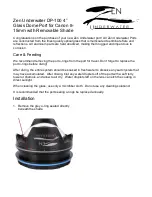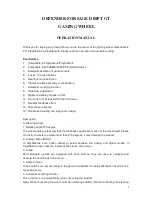
10
The following components are responsible, amongst other things, for the degree of toxicity
of welding fumes:
-
Metals used for the workpiece
-
Electrodes
-
Coatings
-
Cleaners, degreasers, etc.
-
Welding process used
The relevant material safety data sheets and manufacturer's specifications for the listed
components should therefore be studied carefully.
Recommendations for trade fair scenarios, risk management measures and for identifying
working conditions can be found on the European Welding Association website under
Health & Safety (https://european-welding.org).
Flammable vapours (e.g. solvent fumes) should be kept away from the arc's radiation area.
Close the shielding gas cylinder valve or main gas supply if no welding is taking place.
Danger from fly
-
ing sparks
Flying sparks may cause fires or explosions.
Never weld close to flammable materials.
Flammable materials must be at least 11 metres (36 ft. 1.07 in.) away from the arc, or al
-
ternatively covered with an approved cover.
A suitable, tested fire extinguisher must be available and ready for use.
Sparks and pieces of hot metal may also get into adjacent areas through small gaps or
openings. Take appropriate precautions to prevent any danger of injury or fire.
Welding must not be performed in areas that are subject to fire or explosion or near sealed
tanks, vessels or pipes unless these have been prepared in accordance with the relevant
national and international standards.
Do not carry out welding on containers that are being or have been used to store gases,
propellants, mineral oils or similar products. Residues pose an explosive hazard.
Risks from mains
current and weld
-
ing current
An electric shock is potentially life threatening and can be fatal.
Do not touch live parts either inside or outside the device.
During MIG/MAG welding and TIG welding, the welding wire, the wirespool, the feed rollers
and all pieces of metal that are in contact with the welding wire are live.
Always set the wirefeeder up on a sufficiently insulated surface or use a suitable, insulated
wirefeeder holder.
Make sure that you and others are protected with an adequately insulated, dry base or cov
-
er for the earth or ground potential. This base or cover must extend over the entire area
between the body and the earth or ground potential.
All cables and leads must be secured, undamaged, insulated and adequately dimen
-
sioned. Replace loose connections and scorched, damaged, or inadequately dimensioned
cables and leads immediately.
Use the handle to ensure the power connections are tight before every use.
In the case of power cables with a bayonet connector, rotate the power cable around the
longitudinal axis by at least 180° and pretension.
Do not wrap cables or leads around the body or parts of the body.
Summary of Contents for FK 5000
Page 2: ...2...
Page 4: ...4...
Page 18: ...18...
Page 19: ...General...
Page 20: ......
Page 25: ...Connections and mechanical compo nents...
Page 26: ......
Page 28: ...28...
Page 29: ...Installation and commissioning...
Page 30: ......
Page 35: ...35 EN 1 2 1 3 3 2 4 5 6 1 4...
Page 40: ...40...
Page 41: ...Troubleshooting...
Page 42: ......
Page 47: ...Care maintenance and disposal...
Page 48: ......
Page 56: ...56...
Page 57: ...Technical data...
Page 58: ......











































